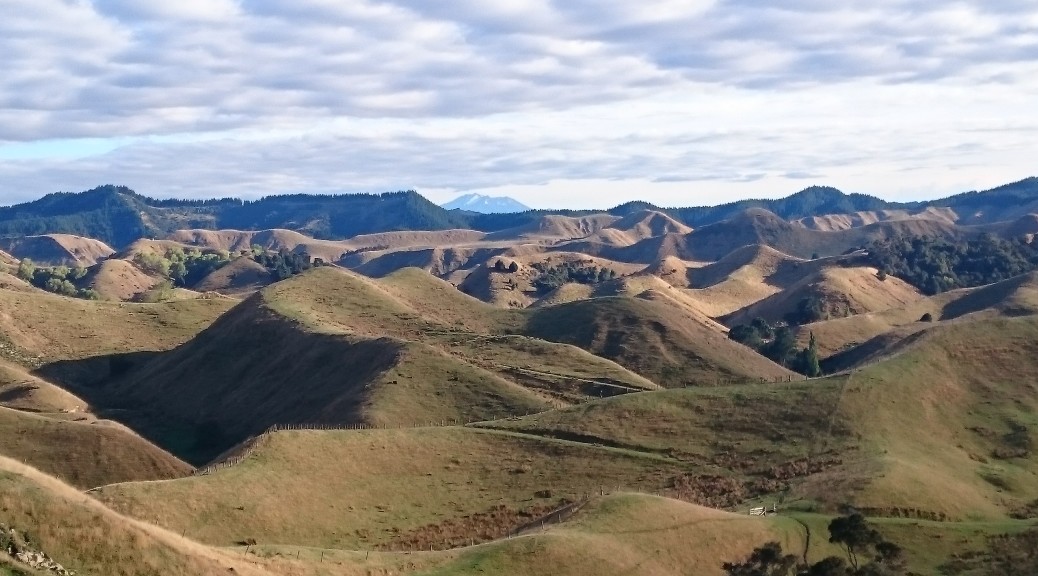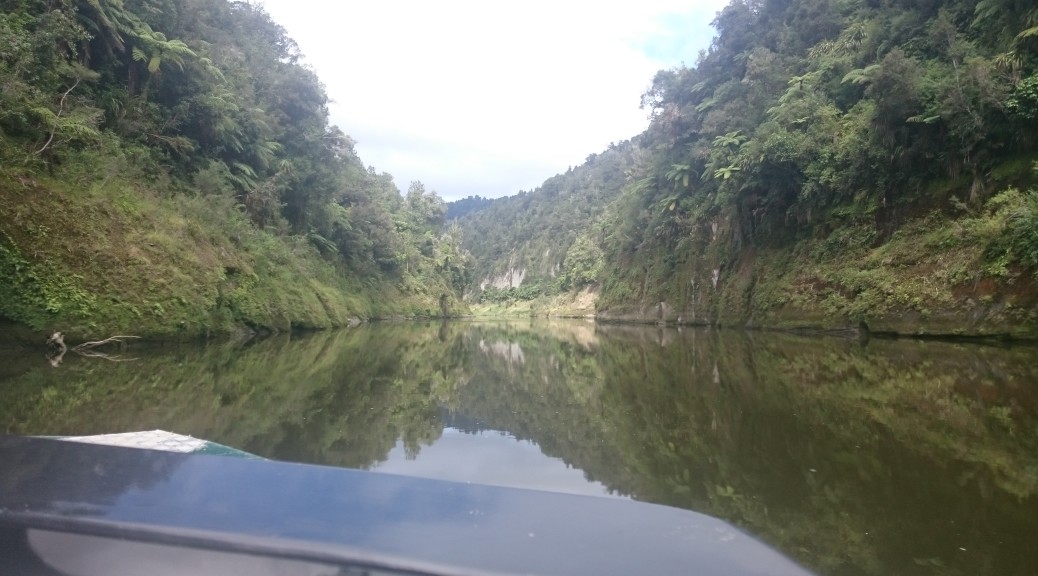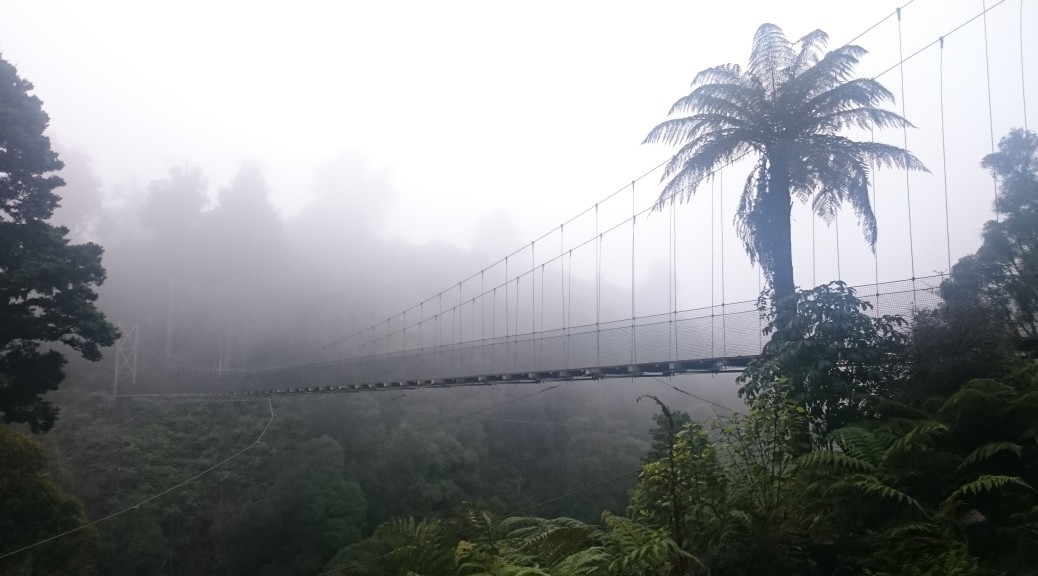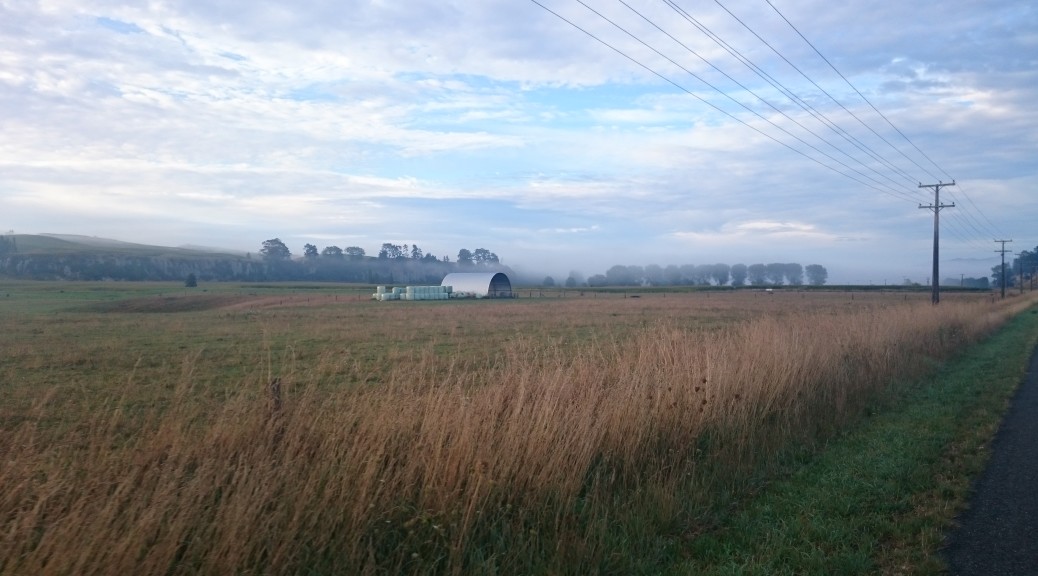On the face of it, riding from Whanganui to Palmerston North should be a matter of four or five hours with little climbing. But that would be on highway and not nearly interesting enough for our route. Cue a rural route more than two and a half times as long, strewn with hills and six or seven times more climbing – on a lot of gravel roads. While this may sound a less attractive option – it was fantastic and I loved this day through northern Manawatu. Some may bemoan more farmland, but I found it beautiful, the hills not too bad and my favourite day of the Tour.
You’d have struggled to convince me of that assertion after ninety minutes of pre-dawn struggling into a stiff easterly towards Fordell. I had to stop and have a breather in the shelter of a still-closed store there. Knowing the windy reputation of the area, I was trying to prepare myself of two-hundred kilometres of strong headwinds. It wasn’t something I was looking forward to.
However, shortly after, the route turned north and dropped off the plateau into a valley – blissful shelter from the wind. All the hills that we encountered did a great job of keeping the wind from being too bothersome. I’m not sure how that worked as valleys usually funnel wind. Turning east again I was enjoying the rural nature of the ride again – there was plenty to look at.
 I was surprised to see Mt Ruapehu in the distance all of a sudden (it’s the tallest peak in the North Island) as I looked out over all the hills.
I was surprised to see Mt Ruapehu in the distance all of a sudden (it’s the tallest peak in the North Island) as I looked out over all the hills.
Just before I reached Hunterville and State Highway One I had my first sighting of a trail angel. This was very exciting as I’d only heard tales of these wonderful people who provide refreshments trailside to riders of such events as this. I stopped for a while to partake of the homemade comestibles and chat. Despite all the good food, ride on one must. Hunterville was much bigger than I’d ever imagined having driven through on the highway many times. As there was a whole lot of not much as far as food supplies for a hundred kilometres, I managed to force myself to stop for second-breakfast and to buy first-lunch.
After a brief stint on the highway, we turned off at Vinegar Hill (which brought back memories of short-cuts driving to & from university many years ago). The climb after plunging down to the river was much more difficult on a bike; we turned off the sealed road soon after and I was on roads unknown to me once again. The climbing continued – there were more wide vistas, old buildings to catch my interest and few cars. With excellent cycling weather – warm, but cloudy enough to not be hot, no wind – the miles ticked by easily.


Just as I was getting peckish again – it had been a few hours since a meal, one can’t survive on bags of crisps and sweets alone – I found a little shaded turn-out at an ex-village. A pleasant spot for lunch. Here’s the history, if you can read it:

 Old buildings continued to pique my interest.
Old buildings continued to pique my interest.
 Rangiwahia was bigger than I would have imagined if I’d ever heard of it. It would have been nice to poke around a bit and stay at the campground – but it was only just after noon. On to Palmy.
Rangiwahia was bigger than I would have imagined if I’d ever heard of it. It would have been nice to poke around a bit and stay at the campground – but it was only just after noon. On to Palmy.
The highest point of the day came just as the route turned south towards Ashhurst – and about as close to the Ruahine Ranges as we got. From there it was downhill overall for the ninety kilometres to Palmy – but when there are rivers and valleys involved it’s never that simple.
 Pleasant enough plains for a while.
Pleasant enough plains for a while.

 Until you reach a valley carved out by water flowing out of the ranges – a big plunge and a steep climb to recover most of the altitude lost. You can just see the road going down the valley wall towards the left of this picture.
Until you reach a valley carved out by water flowing out of the ranges – a big plunge and a steep climb to recover most of the altitude lost. You can just see the road going down the valley wall towards the left of this picture.
 The clouds building up said the weather might not be so benign for so long.
The clouds building up said the weather might not be so benign for so long.
 I’d never been to Apiti either – I found the street signs caused a little bit of confusion.
I’d never been to Apiti either – I found the street signs caused a little bit of confusion.
There was a steep gravel downhill before the last tough climb of the day before dropping into the Pohangina Valley – things started to look familiar as I enjoyed a great day ride here a few months before as a little bit of reconnaissance. I stopped to visit the large totara trees that served as a photo checkpoint before carrying on down the valley. As I neared Palmerston North, the headwind strengthed – of course. I’d have been a fool to expect anything else.

Although it wasn’t far to the city, I knew there weren’t many shops on the route – it followed the bridle path besides the Manawatu. At least, that’s my excuse for stopping for second-lunch in Ashhurst. Still battling the wind I was content to call it a day in Palmy just shy of two hundred kilometres. The chance to stop riding before dark, and most importantly, do some washing was golden. While I’d had many more showers than I expected I would, my shirt in particular was pretty rank and seemed to be losing flexibility and setting into some shape with all the grime and sweat.
After the shorter first three days, I was now well into the groove of the Tour and clearly getting stronger and more able to ride for about twelve hours a day. Naturally this was pleasing, if a little surprising to me – especially as my legs never really complained about the hills. That’s not to say I was particularly fast, but I’d found a pace that I felt I could keep up for as long as necessary. Beautiful scenery, exploring this small but scenery-packed country and good weather also helped with well-pleased mood too.



 Found this where the track met the road/track in from Raetihi. Bike looking very lightly loaded as I’m wearing all my wet-weather gear.
Found this where the track met the road/track in from Raetihi. Bike looking very lightly loaded as I’m wearing all my wet-weather gear.
 Every so often there would be some sort of introduced flowering plant still surviving – the contrast was stark. Still quite a few non-native pines growing strongly.
Every so often there would be some sort of introduced flowering plant still surviving – the contrast was stark. Still quite a few non-native pines growing strongly. There were also many small signs with surnames displayed – remembering the families that had those particular plots. This simple method of memorial was quite poignant – as there really is very little left showing forty-odd families lived here.
There were also many small signs with surnames displayed – remembering the families that had those particular plots. This simple method of memorial was quite poignant – as there really is very little left showing forty-odd families lived here. Across the valley – there are many ferns there reclaiming the grassland.
Across the valley – there are many ferns there reclaiming the grassland. The riding was pretty easy, still heading down. There were quite a few bits where riders were advised to walk – but as they had nothing on the
The riding was pretty easy, still heading down. There were quite a few bits where riders were advised to walk – but as they had nothing on the  It was built to give better access for the families described above – to save them clambering up & down the valley walls. But by the time it was built they had the road (that I’d just ridden in on from the north) for access – so it was of little use and therefore little used as river access was no longer important.
It was built to give better access for the families described above – to save them clambering up & down the valley walls. But by the time it was built they had the road (that I’d just ridden in on from the north) for access – so it was of little use and therefore little used as river access was no longer important. My bike, a rock and quite a river.
My bike, a rock and quite a river. So it happened that I did get a ride on this boat – I think we had ten bikes and riders. I was pleased my bike didn’t go on a rack projecting out from the stern.
So it happened that I did get a ride on this boat – I think we had ten bikes and riders. I was pleased my bike didn’t go on a rack projecting out from the stern.

 Number plate shed caught my eye.
Number plate shed caught my eye.


 Standing fifty-odd metres above the valley floor, one gets a good idea of how dense the forest really is.
Standing fifty-odd metres above the valley floor, one gets a good idea of how dense the forest really is. It’s quite a way down – I’m glad this wasn’t a standard-issue DOC swing-bridge.
It’s quite a way down – I’m glad this wasn’t a standard-issue DOC swing-bridge.

 The trail then followed an old bush tramway that was used to haul logs out from all over this part of the forest – much smoother riding on a gentle gradient.
The trail then followed an old bush tramway that was used to haul logs out from all over this part of the forest – much smoother riding on a gentle gradient. The Ongarue Spiral – a very small railway spiral, but interesting as it used both a bridge and a tunnel.
The Ongarue Spiral – a very small railway spiral, but interesting as it used both a bridge and a tunnel. Heading for the tunnel exit.
Heading for the tunnel exit. As if I needed a reminder that the North Island is very hilly. They never get particularly big or mountainous; but by gosh, there are a lot of them.
As if I needed a reminder that the North Island is very hilly. They never get particularly big or mountainous; but by gosh, there are a lot of them. General consensus seemed to be that the North Island topography was much more punishing than the South. Having done my small amount of training on the hills behind Hawke’s Bay, I was at least a little conditioned for this.
General consensus seemed to be that the North Island topography was much more punishing than the South. Having done my small amount of training on the hills behind Hawke’s Bay, I was at least a little conditioned for this. I think it was in this isolated place I started taking photos of curious, remote buildings from another time. This community hall is still occasionally used, apparently – I saw no signs of such.
I think it was in this isolated place I started taking photos of curious, remote buildings from another time. This community hall is still occasionally used, apparently – I saw no signs of such. The gravel road riding was excellent.
The gravel road riding was excellent.
 Sunrise wasn’t too bad as I breakfasted.
Sunrise wasn’t too bad as I breakfasted. The first sun of the day hits Hobbiton – another photo checkpoint.
The first sun of the day hits Hobbiton – another photo checkpoint. I thought that the two Triumphs one of my early primary school teachers owned was excessive, evidently not.
I thought that the two Triumphs one of my early primary school teachers owned was excessive, evidently not.

 A sign of things to come – big swing bridges began to appear. This one, I think, was used in the construction of one of the many hydro power stations on the river.
A sign of things to come – big swing bridges began to appear. This one, I think, was used in the construction of one of the many hydro power stations on the river. Steve insisted he get a photo of me – I was bemused to find this in the weekly division news when I returned to work. But, definitely pleased to have a photo of me riding on the event – even if it’s on a road, & off-route!
Steve insisted he get a photo of me – I was bemused to find this in the weekly division news when I returned to work. But, definitely pleased to have a photo of me riding on the event – even if it’s on a road, & off-route! Fifteen more kilometres of road, the first half was pretty flat before the climbing that would last for much of the rest of the day began.
Fifteen more kilometres of road, the first half was pretty flat before the climbing that would last for much of the rest of the day began. This was easily the worst and most difficult swingbridge of the entire route. It was so skinny, my handlebars would not fit through – and as I couldn’t walk beside my bike and steer it, I definitely could not push it through. The floor was only wire netting, so it was not practical to lift the front of the bike & wheel it through. In the end, I had to walk backwards along the bridge pulling my bike behind me – guiding it through every handlebar barrier; on the way puncturing a dry bag, most annoying. Still, I only had to make one trip along the bridge.
This was easily the worst and most difficult swingbridge of the entire route. It was so skinny, my handlebars would not fit through – and as I couldn’t walk beside my bike and steer it, I definitely could not push it through. The floor was only wire netting, so it was not practical to lift the front of the bike & wheel it through. In the end, I had to walk backwards along the bridge pulling my bike behind me – guiding it through every handlebar barrier; on the way puncturing a dry bag, most annoying. Still, I only had to make one trip along the bridge. A photo of me at a checkpoint! Despite the three pies that day, looking a bit thinner than normal. Geographical centre of the North Island, apparently.
A photo of me at a checkpoint! Despite the three pies that day, looking a bit thinner than normal. Geographical centre of the North Island, apparently. So it happened that I slept next to this relic of a tractor that night.
So it happened that I slept next to this relic of a tractor that night.